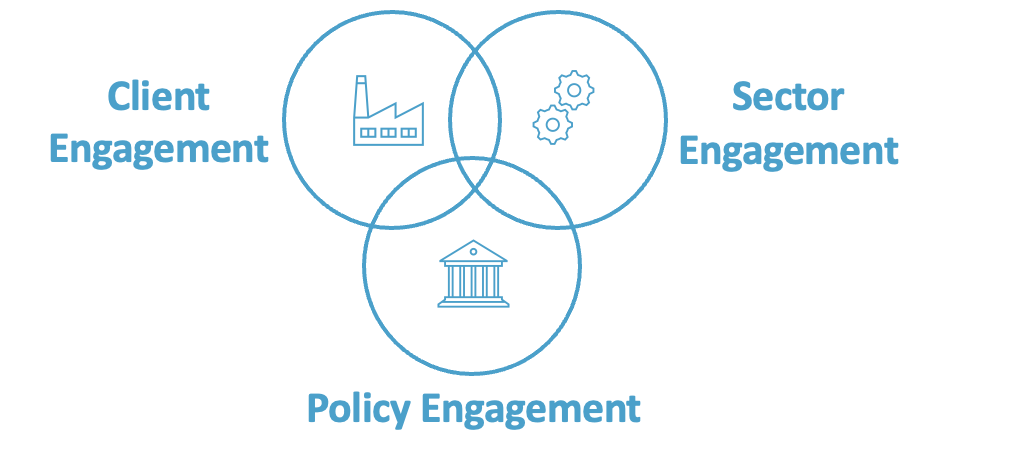
A Banker’s Guide to Maximizing Climate Impact through Multi-Level Engagement
Banks can maximize their climate-focused engagement by coordinating efforts across the client, sector, and policy levels.
Let’s get a contentious issue out of the way: Divestment is one approach banks can take to address climate risks, while continued engagement — which includes efforts like dialogues with high-emitting companies, comment letters during rulemakings, or participation in industry trade groups — is another, and neither comes with a guarantee of climate impact. Divestment alone may not necessarily result in lower emissions in the real economy, while ineffective engagement may enable business-as-usual emissions and continued exposure to potential stranded assets. To maximize the impact that engagement can have, we think it’s time to redefine it. Rather than narrowly focusing on the relationship between a bank and its client, benefits can be unlocked by implementing a new model of “multi-level engagement.”
Multi-Level Engagement: What it is and how it works
Multi-level engagement means coordinating client, sector, and policy engagement to achieve specific climate-aligned outcomes. Under the current engagement paradigm —where different teams across a bank may pursue uncoordinated engagement — efforts are often siloed, hard to measure, and ultimately sometimes ineffective in driving desired outcomes. They could even counteract each other, for instance, when lobbying (a form of policy engagement) impedes climate regulations that might otherwise boost a client company’s progress toward net zero (a likely goal of client engagement). Multi-level engagement focuses a bank’s resources to maximize its impact on climate in the real economy.
Multi-level engagement means, for example, if a bank wants its 10 biggest agriculture clients to publish net-zero transition plans, different teams within the bank could align on an action plan and propose specific, measurable asks to those agriculture clients while also engaging relevant industry groups and regulators who could provide clear guidance or standards on what a credible transition plan looks like. Therefore, multi-level engagement is strategic and outcome-oriented, simultaneously leveraging efforts across stakeholder groups and departments. Coordinated engagements at each level should add up to more than the sum of their parts, achieving more ambitious outcomes with fewer internal resources.

To test and refine this approach, RMI’s Climate Finance program ran a peer workshop series called an ‘Alignment Forum’ through the first half of 2023, convening 44 sustainable finance bankers from 17 global banks across four sessions. The series culminated in a full-day, in-person workshop in New York, which brought together participants from seven European and North American banks representing over $10 trillion in combined total assets. The top takeaways from the workshop are highlighted below.
Internal coordination is as important as external engagement
Banks are often already pursuing climate-focused engagement at the client, sector, and/or policy levels, but it’s rarely coordinated. For instance, the aviation sector desk may not be in sync with the regulatory affairs team even though they are both hoping policymakers upgrade sustainable aviation fuel standards. Banks’ sustainability teams can bring these different teams together to map where and how banks can engage with the most impact.
Sustainability officers can use this new engagement mapping tool to align internal stakeholders around common goals and then plot specific actions at the client, sector, and policy levels. Internal stakeholders could entail banks’ risk, legal, and C-suite teams. Engagement mapping can help banks resource, prioritize, and focus their engagement efforts and is the first step in implementing multi-level engagement.
Better escalation processes are needed
In an ideal world, every bank would have a science-based, net-zero transition plan that incorporates decarbonization pathways for each sector, which would line up perfectly with each of their clients’ transition plans. Then borrowers and lenders would coordinate accordingly. In the real world, we are years away from that, so banks might need to plan their response to major clients whose business plans continue to be misaligned with a bank’s net-zero ambition, despite robust engagement efforts. What then?
Some banks have escalation processes for when clients fail to act following engagement, but they need refining. Current escalation tactics involve bringing in the bank’s climate risk team to explain why, for instance, a client’s capital expenditure plans pose high physical and/or transition risk relative to their peers in the sector. Banks need a set of escalation measures that can help them justify — internally and externally — why they’ve decided to continue engaging a high-risk client or why they’ve deemed the risk-adjusted return inadequate and walked away. There are lessons from the asset management industry, where firms like Insight Investment provide useful case studies on engagement tactics, rationale, and outcomes.
Sector-level engagement must scale
Client engagement is part of a bank’s DNA, and policy engagement is a well-established practice. Sector-level engagement, however, is a relatively new and important framing. Sector-level engagement entails banks coordinating with sector-focused academic institutions, civil society groups, and trade associations. It may also overlap with client- and policy-level stakeholders. Sectoral engagement could help to align on common emissions disclosure metrics or to agree on a feasible sector-wide decarbonization pathway. Climate-aligned finance agreements like the Poseidon Principles in shipping and the Sustainable STEEL Principles in steelmaking solve many of those challenges.
In shipping, for example, banks are engaging global regulators like the International Maritime Organization to increase climate ambitions via the Poseidon Principles. Similar sector-level engagement, while difficult, is required in higher emissions-intensity sectors like oil and gas; power and utilities; automotive; and real estate. While sector-level engagement platforms are nascent, they can be powerful levers for banks, and banks could proactively create those platforms if none are in development. Additionally, while banks may engage those sectors via financial sector trade associations, they may need to deviate from those trade associations that oppose climate alignment and undermine banks’ net-zero plans.
Bank sustainability teams require more resources to unlock engagement’s potential
Aside from internal coordination, escalation policies, and sector-level engagement, the Alignment Forum workshop surfaced several other themes. Geographic differences will greatly affect engagement strategies, banks’ frontline relationship managers require relevant training and incentives, fair access and anti-trust worries hamper engagement in the United States, and engaging downstream clients may have an outsize impact (i.e., indirectly engaging the steel industry by actively engaging carmakers). But one theme underpinned all others: sustainability teams will likely be the connective tissue that coordinates effective engagement, and they need more staff capacity and resources.
Until banks’ sustainability teams are adequately resourced, they’ll need to skillfully compromise and make trade-offs, only focusing on a narrow set of engagement activities. Eventually, climate-focused engagement should be embedded into every banker’s workflow, and it won’t require sustainability team support. Effective, firmwide multi-level engagement could supercharge deal flow as clients embrace low-emissions investments. But that aspiration is years away, and we’ll only get there if well-equipped sustainability teams are empowered by senior management and are supported by fit-for-purpose tools and infrastructure. Effective engagement can help banks keep clients, grow revenues, and lower emissions. It’s time to take engagement to a new level.